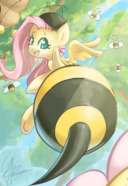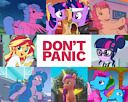Dancing and Decision Making in Honeybee Swarms · 7:29pm May 14th, 2016
My latest story, Bee Kind and Waggle On, is a short look into the world of the honeybee, guided by Fluttershy.
Bees are amazingly interesting insects. Over centuries beekeepers have come to understand their complex society. How a colony of thousands of infertile female worker bees gather the nectar and make the food to support a single queen, who lays her body-weight in eggs every day. These hatch into larvae, which are nurtured by the colony, and develop into workers, male drones, or—if fed ‘royal jelly’—into a new queen. There can only be one queen in the hive, so before the birth of a new princess, the old monarch will depart with part of the colony as a swarm to find a new home. On emerging from her cell, the new virgin queen will then leave the hive on a mating flight to mate with, perhaps a dozen drones (who die in the act). She stores millions of sperm in her abdomen and returns to the nest to take on the egg-laying duty and keep the superorganism alive.
For years beekeepers observed the peculiar dance routines performed by the workers in their hives. The significance of this was deciphered by Karl von Frisch at the University on Munich in the 1940s. He recognised two distinct types of dances. The ‘round dance’ was used by workers to indicate that they had found food close to the hive, while the figure-of-eight ‘waggle dance’ was pointing the direction to more distant food sources. The bee waggles her abdomen while moving along a straight line. The angle of this line to the vertical marks the angle between the sun and the direction to fly. The speed with which she goes through the routine indicates the distance to the source—about one second of waggle run for every kilometre. And the intensity of waggling gives some indication of how good it is.

This leads to the question of how bees can tell where the sun is on a cloudy day. It turns out that their eyes are sensitive to polarised light. Something which humans don’t see, unless wearing the right sunglasses. Sunlight is polarised when scattered by air molecules, with a maximal polarisation 90 degrees from the sun. So just by looking at the sky, bees can orient themselves. This polarization alignment will change through the day as the sun moves across the sky. But bees have evolved a way to account for this. As a bee scout is waggling the day away in the hive, she will adjust the angle of the dance as the sun moves, so the direction she gives to her sisters (relative to the sun) stays the same.
While its primary purpose is to direct foraging bees to food, the waggle dance also plays an important role in how a bee swarm finds a new nesting site. On leaving the hive, up to ten thousand bees will group in a beard like clump on a nearby tree branch. Most the bees stay in a sleepy state clustered around the queen to conserve energy, while a few hundred scouts go off house-hunting. Unless collected by a bee keeper, after, perhaps ten hours, they will fly off to a claim a new nest site.
The process they follow to select their new home has been studied in meticulous detail and documented by Cornell University professor Thomas Seeley. A bee who has found a promising location will return to the swarm and advertise it with a waggle dance. A good site is promoted with a strong waggle, but she will reduce the strength of her dance with time. This causes other scouts to go and check out the site. If they agree it is a good one, they will return and start their own dance. But they may pick another site, and may visit several before deciding on the one to go for. With time the scout who first found it will stop waggling and go back to search mode. Then directed by other wagglers, she may opt for a new site, or go back to the one she picked first time. Over time, the number of bees waggling for each site can rise and fall, but as long as the number of scouts recruited to promote a site exceeds the rate at which they drop off, then the total number waggling for it will grow. Eventually the number of bees opting for one site will reach a quorum, which triggers the whole swarm to wake up and move in.
Prof. Seeley explains that given enough time, the bees will almost always reach a point where they are all dancing for same site, but reaching a consensus is not necessary to trigger take-off, as long as there is a quorum. The collective decision making process has been fine-tuned by millions of years of evolution to achieve the best balance between picking the best nest site, and not taking too much time to do so.
This is of interest not just to entomologists, but also to engineers programming swarms of autonomous robots, and also to those interested in management theory and the question of how to turn a large number of individual preferences into a single group decision.
Consider the fimfiction community. We read stories, and we all have our individual opinion on which is the best. We then upvote and favourite the ones we like, which is the fimfiction version of the doing the waggle dance, which generates the ‘heat’ required to propel the best into the Popular Stories or Feature Box.
Thanks to everyone who waggled for this one.
Further reading: Group Decision Making in Honey Bee Swarms.





Hmm, are you a resident of Factoria, WA by any chance? We just got a co-worker at my job who shares your passion and key memorisation of the facts about honey bees. I'm actually arranging a day to go out and see his hives.
3944396
They can do the full 360 degrees. They are dancing on the side of a honeycomb - so that represents the ground, and 'up' is the direction to the sun.
How the bees sense the dancer is a question I asked a beekeeper at an information day at my local museum, but she didn't know. I'm guessing they must pick up the vibration with their antennae when they brush past, as it must be too dark inside the hive to actually see them.
3944419
No, I'm based in an urban spot in central England. While I like the idea of keeping a hive, I could never keep up with all the work.
Be nice to your co-worker and you just might get a jar of honey.
Similarly, one will observe traders wiggling their bottoms erratically on the trading floor as prices find their new equilibrium.
Commercial beekeepers picked up more of the african bees because they make more honey and are more vicious to invaders. Thats why you had all those 1970s disaster movies about killer bee swarms. They can be set off really easy, and when one bee attacks, its dieing releases a kill this target pheremone. Very unpleasant.
3944526
Already did, he brought them in for us to sample what true natural honey is like.
Also found this if you haven't seen it yet:
I don't know why, but literally anything becomes adorable to me when I see it eating. And honey bees are no different it seems.
So adorable.
3945431 Sensible, but I can't say I'm entirely satisfied with that explanation... Because getting a lot of the details right seems important, but I didn't think this method of observing them would be precise enough. But what other options are there? How dark is it in the hive over the full range of a bees' eyesight?